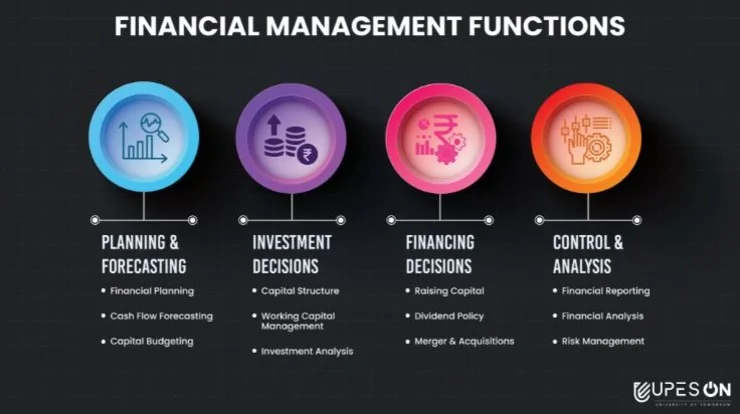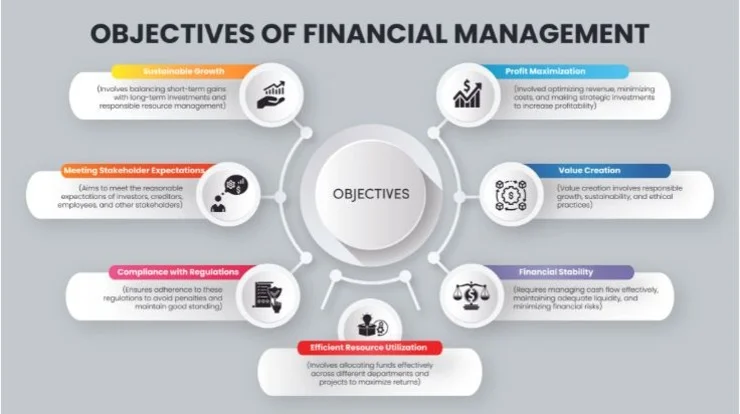50 Top Commonly Asked Financial Management Interview Questions

Are you gearing up for an interview in the field of financial management? Congratulations on securing the opportunity! To help you prepare effectively, we’ve compiled a comprehensive list of financial management interview questions. These questions can be categorized into 3 main types:
1. Commonly Asked Questions
2. Technical Skills
- Accounting and Finance
- Financial Analysis
- Financial Modeling
- Investment Analysis
3. Behavioral & Situational Questions
- Leadership and Teamwork
- Problem-solving and Decision-making
- Communication and Interpersonal Skills
- Analytical and Critical Thinking
Commonly Asked Questions
1. Tell me about yourself:
- Picture this as your opening act—give them a snapshot of your journey through the financial realm, featuring the highlights and top-notch achievements.
Why do you want to work in financial management?
- Let your passion for finance shine through! Show them how you’re the financial wizard they’ve been waiting for.
What do you know about our company and industry?
- It’s time to impress with your research prowess—drop some knowledge bombs about their company and industry trends.
What are your strengths and weaknesses as a financial manager?
- Be real, but smart—highlight your strengths that align with the role and reveal your superpower for conquering your weaknesses.
Technical Questions
Questions on Accounting & Finance Fundamentals
1. Briefly explain the differences between the three main financial statements: income statement, balance sheet, and cash flow statement.
Answer:
- Income statement: Summarizes a company’s revenues and expenses over a specific period (e.g., quarter, year), reflecting its profitability.
- Balance sheet: Provides a snapshot of a company’s financial position at a specific point in time, showing its assets, liabilities, and shareholders’ equity.
- Cash flow statement: Details the cash inflows and outflows from a company’s operating, investing, and financing activities during a specific period.
2. Calculate the current ratio and debt-to-equity ratio for a company given its balance sheet information. Explain what these ratios tell you about the company’s financial health.
Answer:
- Current ratio: Current assets / Current liabilities (measures short-term debt repayment ability).
- Debt-to-equity ratio: Total debt / Shareholders’ equity (indicates financial leverage and risk).
Interpretation:
- A high current ratio suggests better short-term liquidity, but too high might imply inefficient asset utilization.
- A moderate debt-to-equity ratio indicates a balance between borrowing and equity financing, while a high ratio suggests higher financial risk.
3. What are the main differences between capital expenditures (CapEx) and operating expenses (OpEx)? How do they impact a company’s financial statements?
Answer:
- CapEx: One-time expenditures on long-term assets like property, equipment, or software (impacts balance sheet primarily).
- OpEx: Ongoing expenses incurred for day-to-day operations like salaries, rent, and utilities (impacts income statement primarily).
Impact:
- CapEx increases assets and potentially future cash flows, but may impact current liquidity.
- OpEx directly affects profitability and cash flow, with higher expenses typically reducing profit.
4. Explain the concept of time value of money (TVM) and how it impacts investment decisions.
Answer:
- TVM recognizes that a dollar today is worth more than a dollar tomorrow due to potential earning power.
- It helps compare cash flows at different points in time by discounting or compounding them to a present or future value.
Impact:
- Investors use TVM to evaluate the present value of future returns and compare investment options.
- Understanding TVM is crucial for assessing risk, return, and optimal investment timing.
5. Briefly explain the different types of financial analysis used to assess a company’s performance and prospects.
Answer:
- Horizontal analysis: Compares financial statements over time to identify trends and growth.
- Vertical analysis: Expresses different financial statement items as percentages of a base metric (e.g., revenue) to evaluate their relative contribution.
- Ratio analysis: Calculates specific ratios (e.g., profitability, liquidity, efficiency) to gauge various aspects of financial health.

Questions on Financial Analysis
1. Analyze the given company’s recent financial statements (income statement, balance sheet, cash flow statement) and discuss key trends and areas of concern.
Answer: This is an open-ended question that tests your analytical skills and ability to interpret financial data. Start by outlining the company’s overall financial performance (revenue growth, profitability, etc.). Then, delve deeper into specific trends across statements, like:
- Income statement: Revenue sources, expense growth, margin changes.
- Balance sheet: Asset growth, debt levels, inventory turnover.
- Cash flow statement: Operating cash flow generation, investment activities, debt servicing.
Identify areas of concern like declining margins, increasing debt, or negative cash flow, and explain potential causes and implications.
2. Calculate and interpret key financial ratios for the company (e.g., profitability ratios, liquidity ratios, efficiency ratios). What do they tell you about the company’s financial health and risk profile?
Answer: Choose relevant ratios based on the industry and company type. Explain how each ratio is calculated and what a healthy range typically looks like. Then, interpret the calculated ratios for the company:
- Profitability ratios: Assess earning power (e.g., net profit margin, return on equity).
- Liquidity ratios: Gauge short-term debt repayment ability (e.g., current ratio, quick ratio).
- Efficiency ratios: Evaluate resource utilization (e.g., inventory turnover, receivables turnover).
Discuss how these ratios paint a picture of the company’s financial health, strengths, and weaknesses, highlighting potential risks (e.g., high debt-to-equity ratio).
3. You are presented with a financial model for a new project. Evaluate the assumptions and methodology used, identifying potential areas for improvement.
Answer: Demonstrate your financial modeling skills by analyzing the logic and data used in the model. Key points to assess include:
- Assumptions: Are they realistic and based on credible sources? Are sensitivity analyses performed to test their impact?
- Methodology: Is the chosen method appropriate for the project? Are there alternative approaches, and how would they change the results?
- Data sources: Are the data reliable and consistent? Can alternative sources provide more accurate or relevant information?
Provide constructive feedback and suggest potential improvements to strengthen the model’s accuracy and usefulness.
4. Compare the financial performance of two companies within the same industry. Use relevant metrics and highlight key differences and similarities.
Answer: This tests your ability to compare companies on a like-for-like basis. Choose meaningful metrics based on the industry dynamics (e.g., market share, growth rate, profitability margin). Explain the factors contributing to each company’s performance and identify potential competitive advantages or disadvantages.
5. Explain how you would use financial analysis to support a specific business decision (e.g., capital budgeting, merger & acquisition).
Answer: Highlight your understanding of how financial analysis informs decision-making. Choose a specific scenario and outline:
- Relevant financial metrics and analysis: Explain which metrics are crucial for your chosen decision.
- How the analysis will be used: Discuss how the insights will be incorporated into the decision-making process (e.g., evaluating project feasibility, assessing deal risk).
Questions on Financial Modeling
1. Walk me through your process for building a three-statement financial model from scratch.
Answer: Explain your step-by-step approach, emphasizing key elements like:
- Data gathering and assumptions: Discuss reliable sources and the importance of realistic assumptions.
- Building the income statement: Detail revenue forecasting methods and expense calculations.
- Linking to the balance sheet: Explain how income statement items impact balance sheet accounts.
- Creating the cash flow statement: Highlight methods for estimating operating, investing, and financing cash flows.
- Validation and testing: Emphasize the importance of checking formulas, assumptions, and model outputs for accuracy.
2. Explain how you would handle complex calculations or functions within a financial model.
Answer: Showcase your technical proficiency by discussing specific examples, like:
- Using advanced Excel functions like VLOOKUP or INDEX/MATCH for efficient data manipulation.
- Employing macros or VBA for automating repetitive tasks or complex calculations.
- Integrating external data sources or building dynamic scenarios for sensitivity analysis.
3. Describe a situation where you encountered an error in a financial model. How did you identify and fix the issue?
Answer: Highlight your problem-solving skills by sharing a real-world experience:
- Explain the error you encountered and how you diagnosed it (e.g., checking formulas, tracing cell references).
- Describe the steps you took to rectify the error and ensure model accuracy.
- Emphasize your attention to detail and ability to troubleshoot effectively.
4. What best practices do you follow to ensure your financial models are transparent, user-friendly, and well-documented?
Answer: Demonstrate your commitment to clear communication and efficient workflow:
- Explain using clear cell names, comments, and formatting for easy understanding.
- Discuss incorporating documentation within the model itself, outlining assumptions, formulas, and methodology.
- Highlight the importance of creating user-friendly interfaces for easy navigation and data input.
5. Briefly describe a financial modeling project you are proud of and the challenges you faced during its development.
Answer: Showcase your accomplishments and problem-solving abilities by sharing a specific project:
- Briefly explain the project’s purpose and your role in developing the model.
- Discuss the key challenges you encountered (e.g., limited data, complex calculations).
- Highlight your innovative solutions and the positive impact of your work.
Questions on Investment Analysis
1. Describe your investment philosophy and approach to evaluating potential investments.
Answer: This open-ended question assesses your overall understanding of investment principles and risk tolerance. Briefly explain:
- Investment style: Value investing, growth investing, income investing, etc.
- Risk-return considerations: How you balance potential returns with associated risks.
- Fundamental analysis vs. technical analysis: Your preferred methods for evaluating investments.
- Specific tools and resources: Mention relevant financial news sources, research platforms, or analysis tools you use.
2. Given a specific company or investment scenario, analyze its key strengths, weaknesses, opportunities, and threats (SWOT).
Answer: Demonstrate your research and analytical skills by delving into a specific case:
- Strengths: Competitive advantages, financial health, brand recognition, etc.
- Weaknesses: Internal limitations, product weaknesses, operational inefficiencies, etc.
- Opportunities: Potential market growth, expansion plans, new product launches, etc.
- Threats: Industry competition, regulatory changes, economic downturns, etc.
- Investment decision: Based on the SWOT analysis, discuss your rationale for investing or not investing.
3. Explain how you would calculate and interpret key valuation metrics for a company (e.g., P/E ratio, EV/EBITDA, DCF).
Answer: Showcase your understanding of common valuation methods:
- P/E ratio: Price-to-earnings ratio indicating relative valuation compared to peers.
- EV/EBITDA: Enterprise value-to-earnings before interest, taxes, depreciation, and amortization, considering company debt.
- DCF (Discounted Cash Flow): Estimating the present value of future cash flows to assess intrinsic value.
Explain how you calculate and interpret each metric for the given company, highlighting its limitations and incorporating other valuation methods for a comprehensive view.
4. Discuss your approach to portfolio diversification and managing risk.
Answer: Demonstrate your understanding of risk management:
- Asset allocation: Explain how you diversify across different asset classes (stocks, bonds, real estate) and sectors.
- Risk-adjusted returns: Discuss prioritizing investments that offer optimal returns relative to their risk level.
- Rebalancing: Explain how you periodically adjust your portfolio to maintain your desired risk profile.
5. Describe a past investment decision you made, the analysis behind it, and the outcome.
Answer: Share a real-world experience to showcase your decision-making and reflection skills:
- Briefly explain the investment you made and your reasons for choosing it.
- Discuss the analysis you conducted (financial statements, industry trends, etc.).
- Highlight the outcome of the investment and your learnings from the experience.

Behavioral and Situational questions
Leadership and Teamwork Questions for Financial Management
1. Describe a situation where you demonstrated effective leadership in a financial context. What were the challenges you faced, and how did you overcome them?
Answer:
- Briefly describe the situation and your leadership role (e.g., project leader, team mentor).
- Highlight the challenges you faced, such as budget constraints, conflicting priorities, or team member disagreements.
- Explain how you used your leadership skills to address these challenges. This could involve:
- Clear communication and goal setting: Ensuring everyone understood the objectives and their roles.
- Delegation and empowerment: Assigning tasks based on strengths and fostering ownership.
- Motivating and inspiring: Creating a positive team environment and recognizing individual contributions.
- Conflict resolution: Facilitating open communication and finding solutions that benefit everyone.
- Quantify the impact of your leadership, if possible (e.g., improved financial performance, increased team morale).
2. How do you approach building trust and fostering collaboration within a financial team?
Answer:
- Emphasize the importance of trust and collaboration for strong financial performance.
- Outline specific strategies you use, such as:
- Open communication and information sharing: Regularly sharing updates, financial data, and rationale behind decisions.
- Active listening and respect for diverse perspectives: Encouraging team members to voice their opinions and valuing different viewpoints.
- Collaborative problem-solving: Engaging the team in brainstorming solutions and decision-making processes.
- Celebrating successes and acknowledging individual contributions: Recognizing achievements and fostering a sense of shared ownership.
3. How do you handle situations where team members have different work styles or priorities?
Answer:
- Acknowledge the challenges of diverse work styles and priorities.
- Discuss your approach to managing these differences, such as:
- Understanding individual strengths and preferences: Identifying how each team member contributes best.
- Clear communication and goal alignment: Setting clear expectations and ensuring everyone understands their responsibilities.
- Flexible and adaptable leadership: Adjusting your approach based on the situation and individual needs.
- Open communication and conflict resolution: Encouraging healthy discussions and finding solutions that work for everyone.
4. Describe a time when you had to delegate a complex financial task to a team member. How did you ensure their success?
Answer:
- Briefly explain the task and the team member’s skill set and experience.
- Highlight your approach to delegation, including:
- Clear communication and instruction: Providing detailed instructions, timelines, and expectations.
- Matching tasks to strengths: Assigning the task based on the team member’s individual capabilities.
- Offering support and resources: Being available for questions and providing necessary information or tools.
- Feedback and recognition: Offering constructive feedback and acknowledging the team member’s accomplishment.
5. How do you measure your effectiveness as a leader and team player?
Answer:
- Go beyond individual achievements and highlight metrics that reflect your impact on the team and organization. This could include:
- Team performance: Improved financial results, increased efficiency, or positive team morale surveys.
- Individual development: Team members taking on more responsibility, acquiring new skills, or receiving promotions.
- Feedback and recognition: Positive feedback from colleagues, manager, or clients.
- Emphasize your continuous learning and growth mindset, seeking feedback and actively looking for ways to improve your leadership and teamwork skills.
Problem-Solving & Decision-Making Interview Questions
1. Describe a complex financial problem you encountered in your previous role. How did you approach it, and what was the outcome?
Answer: Briefly explain the situation and the specific problem you faced (e.g., budget overrun, unexpected financial loss, complex investment decision). Highlight your problem-solving process:
- Gathering information and data: Analyzing relevant financial statements, industry reports, and other sources.
- Identifying possible causes and solutions: Brainstorming various options and conducting thorough research.
- Evaluating each option: Considering feasibility, effectiveness, potential risks and benefits.
- Making a decision and taking action: Choosing the best course of action, implementing it efficiently, and communicating clearly with stakeholders.
- Measuring the outcome: Assessing the impact of your decision and learning from the experience.
2. How do you prioritize tasks and make decisions under pressure in a fast-paced financial environment?
Answer: Emphasize your ability to stay calm and make sound judgments under pressure:
- Understanding priorities and deadlines: Clearly identify critical tasks and their timelines.
- Considering risk and impact: Assess the potential consequences of each decision.
- Seeking input and collaboration: Consulting relevant colleagues and experts if needed.
- Communicating effectively: Keeping stakeholders informed and explaining your reasoning.
- Adapting to changing circumstances: Remaining flexible and adjusting your approach as needed.
3. You are presented with a financial forecast that appears inaccurate. How would you approach this situation?
Answer: Showcase your analytical and communication skills:
- Start by politely expressing your concerns to the person who prepared the forecast.
- Explain your observations and the specific areas where you see potential inaccuracies.
- Work collaboratively to understand the assumptions and methodology used in the forecast.
- If necessary, conduct your own analysis to identify potential errors or missing information.
- Propose adjustments and improvements to the forecast in a constructive and professional manner.
4. Describe a situation where you had to make a financial decision without complete information. How did you navigate the uncertainty?
Answer: Highlight your ability to make informed decisions even with limited data:
- Acknowledge the lack of complete information and explain its potential impact.
- Gather as much relevant data as possible from reliable sources.
- Identify and analyze potential scenarios and outcomes (e.g., best-case, worst-case).
- Communicate the uncertainty and potential risks to stakeholders involved.
- Make a well-reasoned decision based on the available information and justify your reasoning.
5. How do you learn from your mistakes and ensure continuous improvement in your problem-solving and decision-making skills?
Answer: Demonstrate your growth mindset and commitment to learning:
- Reflect on past experiences and identify areas where you could have done better.
- Seek feedback from colleagues, mentors, or supervisors.
- Actively participate in training and development opportunities to enhance your skills.
- Stay informed about industry trends and advancements in financial analysis.
- Challenge yourself with new and complex problems to expand your capabilities.
Communication & Interpersonal Skills
1. Describe a situation where you had to explain a complex financial concept to someone with limited financial knowledge. How did you ensure they understood it?
Answer: Highlight your ability to simplify complex information for diverse audiences:
- Briefly explain the situation and the audience you were communicating with.
- Describe your approach, such as:
- Using clear and concise language, avoiding jargon or technical terms.
- Providing real-world examples and analogies to illustrate the concept.
- Actively listening to questions and concerns and adjusting your explanation accordingly.
- Checking for understanding and asking clarifying questions.
2. How do you manage conflict or disagreements within a team, especially when financial issues are involved?
Answer: Showcase your conflict resolution skills:
- Emphasize the importance of open communication and respectful dialogue.
- Explain your approach to managing conflict, such as:
- Actively listening to all viewpoints and acknowledging concerns.
- Facilitating open and honest communication to identify the root causes of the disagreement.
- Focusing on finding mutually beneficial solutions that consider everyone’s perspectives.
- Maintaining a professional and respectful demeanor throughout the process.
3. Describe a time when you had to persuade someone to accept your financial recommendations. How did you approach the situation?
Answer: Demonstrate your persuasive and negotiation skills:
- Briefly explain the situation and your recommendations.
- Highlight your approach, such as:
- Gathering data and evidence to support your recommendations.
- Tailoring your communication to the individual’s perspective and concerns.
- Addressing their potential objections and providing clear counterarguments.
- Emphasizing the benefits and positive outcomes of your recommendations.
- Being flexible and open to negotiating mutually agreeable solutions.
4. How do you build strong relationships with colleagues and stakeholders in a financial environment?
Answer: Showcase your interpersonal and relationship-building skills:
- Emphasize the importance of trust and collaboration in finance.
- Explain how you build relationships, such as:
- Being reliable, approachable, and open to communication.
- Actively listening to others and showing genuine interest in their perspectives.
- Being respectful and inclusive, valuing diverse viewpoints and contributions.
- Celebrating successes and achievements together as a team.
5. Describe your preferred communication style and how you adapt it to different situations and audiences.
Answer: Demonstrate your versatility and ability to communicate effectively in various settings:
- Explain your preferred communication style (e.g., direct, collaborative, empathetic).
- Highlight how you adapt your style depending on:
- The audience (e.g., colleagues, managers, clients).
- The situation (e.g., formal meeting, informal chat, negotiation).
- The desired outcome (e.g., informing, persuading, collaborating).
Analytical & Critical Thinking Interview Questions
1. You are presented with a set of seemingly unrelated financial data points. Explain how you would approach analyzing the data and identify potential insights or trends.
Answer: Showcase your data analysis skills and ability to uncover hidden patterns:
- Start by describing your initial observations and questions about the data.
- Explain how you would organize and clean the data for analysis (e.g., removing outliers, checking for consistency).
- Discuss various analytical techniques you might use, such as:
- Descriptive statistics: Summarizing key features of the data (e.g., mean, median, standard deviation).
- Correlation analysis: Identifying relationships between different variables.
- Trend analysis: Detecting patterns and changes over time.
- Regression analysis: Building models to explain relationships between variables.
- Emphasize how you would critically evaluate the findings and identify potential limitations of the analysis.
2. Describe a situation where you had to analyze complex financial information and draw conclusions that impacted important decisions. How did you ensure the validity and reliability of your conclusions?
Answer: Highlight your critical thinking and evidence-based decision-making skills:
- Briefly explain the situation and the importance of your conclusions.
- Discuss your approach to ensuring the validity and reliability of your findings:
- Verifying the source of the data and its credibility.
- Considering alternative explanations and potential biases.
- Conducting sensitivity analysis to understand how changes in assumptions might impact your conclusions.
- Seeking feedback and validation from other experts or colleagues.
3. You are presented with a financial forecast that seems overly optimistic. How would you critically evaluate the assumptions and methodology used to arrive at that forecast?
Answer: Demonstrate your ability to challenge assumptions and identify potential risks:
- Start by acknowledging the seemingly optimistic nature of the forecast.
- Explain how you would critically evaluate the key assumptions, such as:
- Economic growth projections.
- Market share estimates.
- Cost and expense expectations.
- Discuss specific techniques you might use, such as scenario planning and stress testing.
- Emphasize your communication skills by explaining your concerns and potential alternative scenarios to stakeholders.
4. How do you stay informed about current financial trends and developments that could impact your work?
Answer: Showcase your commitment to continuous learning and staying updated:
- Mention specific industry publications, reports, and financial news sources you follow.
- Explain how you actively engage in professional development opportunities (e.g., conferences, online courses).
- Discuss how you share new information and insights with your colleagues or team.
5. Describe a situation where you had to make a difficult decision with limited information and potential risks involved. How did you approach the situation, and what was the outcome?
Answer: Highlight your ability to think critically under pressure and make informed decisions even with uncertainty:
- Briefly explain the situation and the limited information available.
- Discuss your thought process, such as:
- Identifying and analyzing the potential risks and rewards of different options.
- Consulting with colleagues or experts for insights and advice.
- Considering the potential impact of your decision on various stakeholders.
- Share the outcome of your decision and any valuable lessons learned.
Recommended Blogs

7 Surprising Benefits of an MBA in Oil and Gas Management
An MBA in Oil and Gas Management helps you advance your career with Leadership Skills, Networking, Global Knowledge, Professional Growth.
Read MoreMar 15, 2024 I 2 minutes
45+ Business Development Interview Qs! (Basic, Concepts, Tech)
Master your Business Development interview prep with 45 most asked questions for freshers, experienced & techies. New Questions updated!
Read MoreFeb 16, 2024 I 10 minutes
Introduction to Renewable Energy Management: What You Need To Know
Discover what is renewable energy management, its importance to the world and the key aspects of managing these energy sources.
Read MoreJan 20, 2023 I 2 minutes
Ace Your Data Governance Interview with these 55 Question Types
Master 55 data governance interview Questions, from data lineage puzzles to AI challenges. Sharpen your skills & land your dream data role.
Read MoreJan 21, 2024 I 15 minutes


